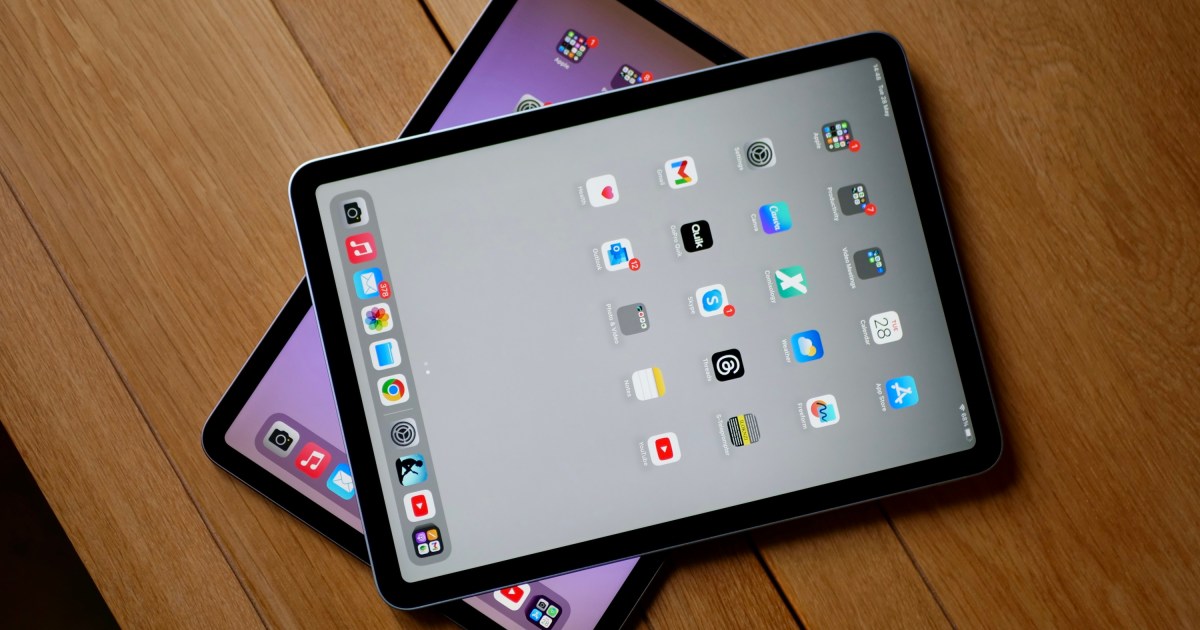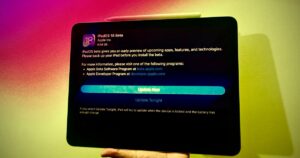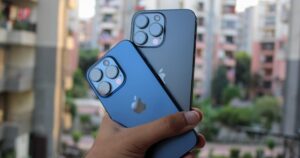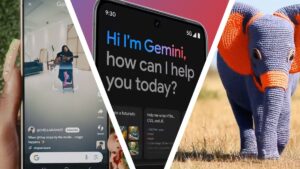Apple finally released some new iPads this year after going more than a year without any updates. The iPad Air got a major refresh, now with an M2 chip inside and a new size — 13 inches — to go along with the regular 11-inch size of before.
The new iPad Air starts at $599 for the 11-inch Wi-Fi base model and goes up depending on the size and configuration you choose. If you want the new 13-inch model, be prepared to spend at least $799.
As great as the new iPad Air is, it’s not the only tablet on the market. Here are five other options you can consider instead.
iPad Pro (2024)
The iPad Air wasn’t the only new iPad Apple gave us this year — we also have the new iPad Pro (2024). If you can afford it, the Pro models have some pretty cool upgrades over the air.
For one thing, the iPad Pro also comes in the same 11-inch and 13-inch sizes that the Air now comes in. However, the iPad Pro takes things a step further with a new OLED display, a first on an iPad, which means you get deeper blacks, brighter colors and an overall sharper display.
If you choose the 1TB or 2TB model, you have the option of a new nano-texture coating. With the nanotexture, it’s an anti-reflective coating that helps reduce glare. While this may mean blacks aren’t as deep as a standard glossy display, it can definitely help when you’re working on the iPad Pro.
The iPad Pro is also the debut device for the powerful M4 chip, which hasn’t even reached the Mac yet. With the M4 chip, you get the same powerful performance as the M2, but with better thermal performance using half the power. According to Apple, it has the same level of performance as a thin and light PC, but with a quarter of the power.
The M4 chip is also a solid foundation for powerful AI tasks thanks to the new Neural Engine it uses. Hopefully this means we’ll be getting some solid AI upgrades and features in iPadOS 18 that will take advantage of the power of this chip.
The iPad Pro (2024) is an expensive tablet, and quite a bit more expensive than the new iPad Air. But if you want the best, most powerful iPad available in 2024, this is the one to get.
iPad Air (2022)
Still want an iPad Air but don’t need the benefits of the new model? The 2022 iPad Air is still a perfectly capable device that shouldn’t be overlooked. Plus, you can save some money by going for this one now that the new model is on the market.
The iPad Air (2022) has an M1 chip that’s a few years old, but it’s still a very fast and powerful chip for a tablet. Although the M2 gives a 50% performance increase over the M1, for most people the M1 is probably more than enough. After all, most people probably use the iPad to check email, message, social network, consume media, and play games. The M1 can handle all of this without a problem.
Even though the iPad Air (2022) is only one size, it still has a beautiful and clear screen. You also have a 12MP rear camera and a front-facing 12MP camera that sits at the top of the device in portrait orientation. It still has USB-C charging and support for the Apple Pencil 2 and Magic Keyboard, so you can get some serious work done on it. The 64GB primary storage can be a sticking point, so it’s recommended to go for a larger storage option if you can.
Despite being two years old, the iPad Air is still a capable machine that is suitable for most people. If you don’t need an M2 chip or a 13-inch iPad Air, then you can definitely save some money by getting an older iPad Air instead.
iPad (2022)
When the 10th generation iPad came out in 2022, it was in a bit of an awkward situation. That’s because Apple continued to sell the ninth-generation iPad at a lower price, and the $450 asking price for the 10th generation was a bit high.
But that’s different now that the ninth-generation iPad is completely out of the picture, as Apple no longer sells it. Because of this, the 10th generation iPad from 2022 has received a price drop to just $350, making it much easier to recommend.
The 10th generation iPad got rid of the relic home button, so it now uses Touch ID in the power button at the top of the bezel. You also have a front-facing camera in landscape orientation, which makes sense for video calls, especially with Center Stage. The iPad also has USB-C charging, which is in line with the rest of Apple’s product lines, which have now all switched to USB-C for the iPhone, iPad, and Mac.
Since the iPad no longer has a home button, it has a larger display with thinner bezels, making it ideal for media consumption. While it’s not the best display since it’s still an LED panel, it’s not bad by any means and is good enough for most people.
The iPad still uses Apple’s older A14 Bionic chip, which was first released in the iPhone 12 and iPad Air 2020 lineup. It may not be the newest or fastest chip, but it’s perfectly adequate for media use. checking social networks and playing some games.
iPad (2022) supports first-generation Apple Pencil and Apple Pencil USB-C. It doesn’t support the Magic Keyboard, but it does have the Magic Keyboard Folio, which is generally more flexible and allows you to be productive with the keyboard and trackpad.
When the iPad (2022) was first released, it was a strange recommendation. But now that its price has come down and it’s still a great tablet for the average person, it’s a solid alternative to the iPad Air (2024).
OnePlus Pad
Don’t mind switching to Android? Then the OnePlus Pad remains one of the best tablets you can get on the market.
The design of the OnePlus Pad definitely stands out in the crowd of boring tablet colors and basic glass slabs. It has a unique Halo Green color with a polished metal look and a circular pattern on the back similar to a vinyl record. It’s also slim in design, lightweight and frankly quite comfortable to hold.
OnePlus shipped the OnePlus Pad with OxygenOS 13 on it and promised three years of Android OS upgrades and four years of security patches. It should be upgradable to Android 16, which is likely to arrive later next year. OxygenOS 13 runs smoothly on the OnePlus Pad and has great multitasking capabilities, so you can maximize productivity — especially when paired with the OnePlus Magnetic Keyboard and OnePlus Stylo.
In terms of specifications, the OnePlus Pad is impressive with 8GB of RAM and the MediaTek Dimensity 9000, one of MediaTek’s higher-end chipsets. One of the great features of the OnePlus Pad is the ability to have up to 24 live apps running simultaneously. The average person may never have 24 apps on screen at once, but it’s nice to have.
Finally, the OnePlus Pad has some of the best battery life on a tablet. The 9510 mAh battery can provide over 12 hours of continuous video viewing sessions and a very impressive one month of standby time. Don’t have accessories or background apps? Then the battery can last about 50 days. And when you need to charge, it has 67W wired charging, so you can go from zero to 100% in about 80 minutes.
Samsung Galaxy Tab S9 FE Plus
Those who were thinking of getting the 13-inch iPad Air (2024) could also consider the Samsung Galaxy Tab S9 FE Plus, as long as you don’t mind Android. You get a similarly sized 12.4-inch tablet without breaking the bank.
With the Samsung Galaxy Tab S9 FE Plus, you have a 12.4-inch WQXGA display that provides a pleasant viewing experience with rich and saturated colors and clear resolution. It also has a 90Hz refresh rate. It’s not 120Hz, but it’s a step up from the iPad Air’s 60Hz screen. This means that scrolling should be a bit smoother than on the iPad Air.
Although it doesn’t use a Snapdragon chip and instead has an Exynos 1380 chipset, it still packs a good mid-range performance with up to 12GB of RAM. It ships with Android 13 and Samsung One UI 5.1.1, but has since been updated to Android 14. The Samsung Galaxy Tab S9 FE Plus also uses Samsung DeX, which replaces the Android interface with one that’s closer to a desktop computer like Windows or macOS. With DeX, it’s a little easier to be more productive on your tablet, but it also depends on whether the apps you use will work well with it.
Battery life on the Samsung Galaxy Tab S9 FE Plus is also good. With continuous use, such as watching a video, you can get between 18 and 20 hours on a single charge of the 10,090 mAh battery. It also charges quickly, getting a full charge in less than 90 minutes.
There’s a lot to like about the Samsung Galaxy Tab S9 FE Plus, especially the price if you’re looking for a bigger tablet without spending too much.
Editors’ recommendations



